OPEL KARL 2015 Service Manual
Manufacturer: OPEL, Model Year: 2015, Model line: KARL, Model: OPEL KARL 2015Pages: 217, PDF Size: 4.16 MB
Page 41 of 217
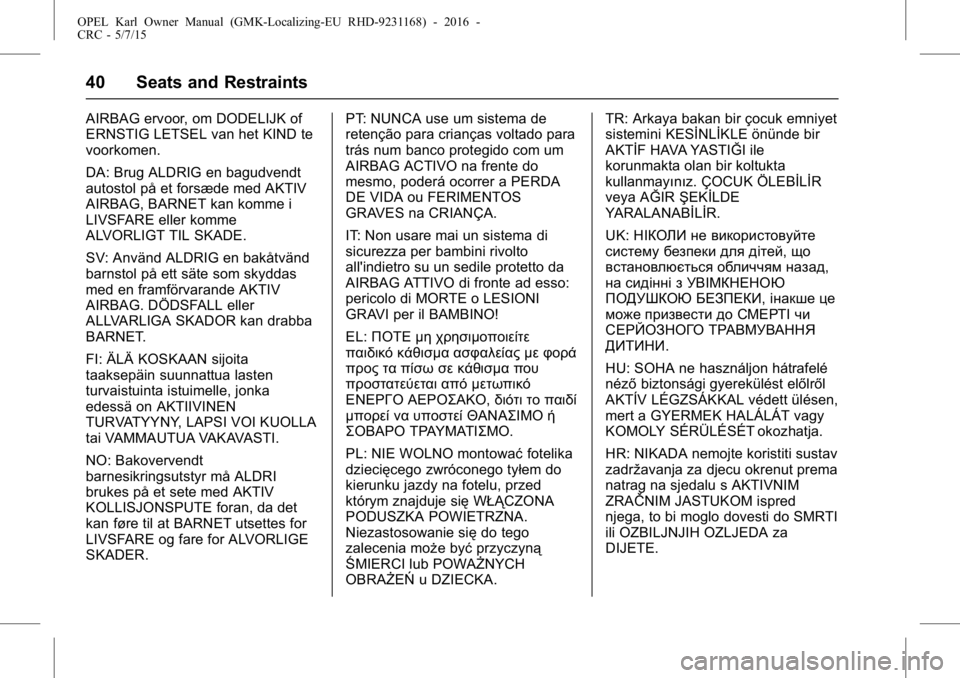
OPEL Karl Owner Manual (GMK-Localizing-EU RHD-9231168) - 2016 -
CRC - 5/7/15
40 Seats and Restraints
AIRBAG ervoor, om DODELIJK of
ERNSTIG LETSEL van het KIND te
voorkomen.
DA: Brug ALDRIG en bagudvendt
autostol på et forsæde med AKTIV
AIRBAG, BARNET kan komme i
LIVSFARE eller komme
ALVORLIGT TIL SKADE.
SV: Använd ALDRIG en bakåtvänd
barnstol på ett säte som skyddas
med en framförvarande AKTIV
AIRBAG. DÖDSFALL eller
ALLVARLIGA SKADOR kan drabba
BARNET.
FI: ÄLÄ KOSKAAN sijoita
taaksepäin suunnattua lasten
turvaistuinta istuimelle, jonka
edessä on AKTIIVINEN
TURVATYYNY, LAPSI VOI KUOLLA
tai VAMMAUTUA VAKAVASTI.
NO: Bakovervendt
barnesikringsutstyr må ALDRI
brukes på et sete med AKTIV
KOLLISJONSPUTE foran, da det
kan føre til at BARNET utsettes for
LIVSFARE og fare for ALVORLIGE
SKADER.PT: NUNCA use um sistema de
retenção para crianças voltado para
trás num banco protegido com um
AIRBAG ACTIVO na frente do
mesmo, poderá ocorrer a PERDA
DE VIDA ou FERIMENTOS
GRAVES na CRIANÇA.
IT: Non usare mai un sistema di
sicurezza per bambini rivolto
all'indietro su un sedile protetto da
AIRBAG ATTIVO di fronte ad esso:
pericolo di MORTE o LESIONI
GRAVI per il BAMBINO!
EL:
ΠΟΤΕ μη χρησιμοποιείτε
παιδικό κάθισμα ασφαλείας με φορά
προς τα πίσω σε κάθισμα που
προστατεύεται από μετωπικό
ΕΝΕΡΓΟ ΑΕΡΟΣΑΚΟ, διότι το παιδί
μπορεί να υποστεί ΘΑΝΑΣΙΜΟ ή
ΣΟΒΑΡΟ ΤΡΑΥΜΑΤΙΣΜΟ.
PL: NIE WOLNO montować fotelika
dziecięcego zwróconego tyłem do
kierunku jazdy na fotelu, przed
którym znajduje się WŁĄCZONA
PODUSZKA POWIETRZNA.
Niezastosowanie się do tego
zalecenia może być przyczyną
ŚMIERCI lub POWAŻNYCH
OBRAŻEŃ u DZIECKA. TR: Arkaya bakan bir çocuk emniyet
sistemini KESİNLİKLE önünde bir
AKTİF HAVA YASTIĞI ile
korunmakta olan bir koltukta
kullanmayınız. ÇOCUK ÖLEBİLİR
veya AĞIR
ŞEKİLDE
YARALANABİLİR.
UK: НІКОЛИ не використовуйте
систему безпеки для дітей, що
встановлюється обличчям назад,
на сидінні з УВІМКНЕНОЮ
ПОДУШКОЮ БЕЗПЕКИ, інакше це
може призвести до СМЕРТІ чи
СЕРЙОЗНОГО ТРАВМУВАННЯ
ДИТИНИ.
HU: SOHA ne használjon hátrafelé
néző biztonsági gyerekülést előlről
AKTÍV LÉGZSÁKKAL védett ülésen,
mert a GYERMEK HALÁLÁT vagy
KOMOLY SÉRÜLÉSÉT okozhatja.
HR: NIKADA nemojte koristiti sustav
zadržavanja za djecu okrenut prema
natrag na sjedalu s AKTIVNIM
ZRAŜŦNIM JASTUKOM ispred
njega, to bi moglo dovesti do SMRTI
ili OZBILJNJIH OZLJEDA za
DIJETE.
Page 42 of 217
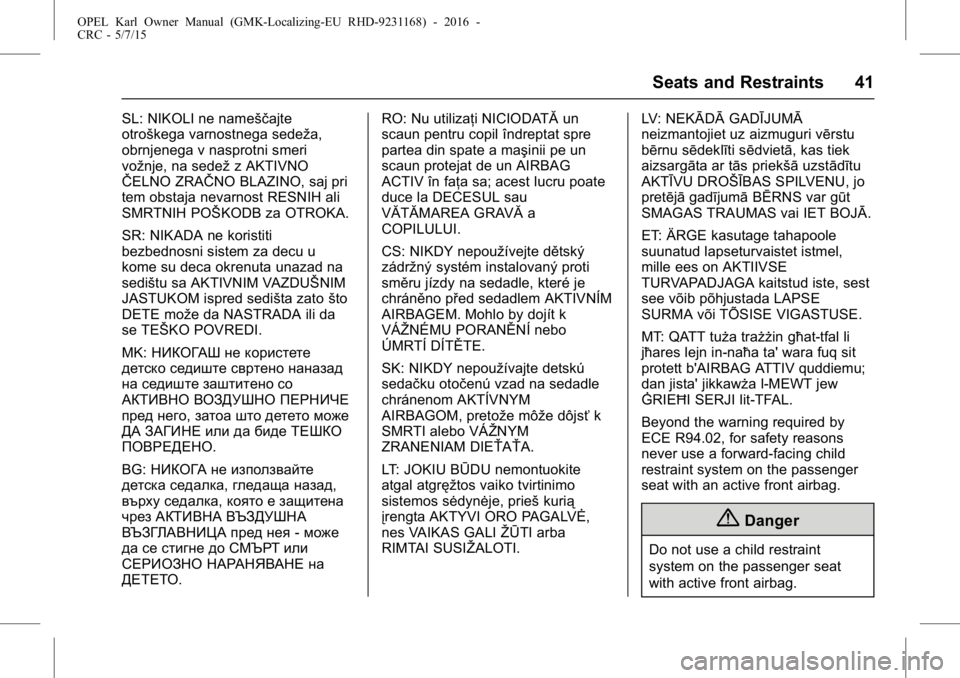
OPEL Karl Owner Manual (GMK-Localizing-EU RHD-9231168) - 2016 -
CRC - 5/7/15
Seats and Restraints 41
SL: NIKOLI ne nameščajte
otroškega varnostnega sedeža,
obrnjenega v nasprotni smeri
vožnje, na sedežz AKTIVNO
ŜŦELNO ZRAŜŦNO BLAZINO, saj pri
tem obstaja nevarnost RESNIH ali
SMRTNIH POŠKODB za OTROKA.
SR: NIKADA ne koristiti
bezbednosni sistem za decu u
kome su deca okrenuta unazad na
sedištu sa AKTIVNIM VAZDUŠNIM
JASTUKOM ispred sedišta zato što
DETE može da NASTRADA ili da
se TEŠKO POVREDI.
MK: НИКОГАШ не користете
детско седиште свртено наназад
на седиште заштитено со
АКТИВНО ВОЗДУШНО ПЕРНИЧЕ
пред него, затоа што детето може
ДА ЗАГИНЕ или да биде ТЕШКО
ПОВРЕДЕНО.
BG: НИКОГА не използвайте
детска седалка, гледаща назад,
върху седалка, която е защитена
чрез АКТИВНА ВЪЗДУШНА
ВЪЗГЛАВНИЦА пред нея -може
да се стигне до СМЪРТ или
СЕРИОЗНО НАРАНЯВАНЕ на
ДЕТЕТО. RO: Nu utilizaţi NICIODATĂ
un
scaun pentru copil îndreptat spre
partea din spate a maşinii pe un
scaun protejat de un AIRBAG
ACTIV în faţa sa; acest lucru poate
duce la DECESUL sau
VĂTĂMAREA GRAVĂ a
COPILULUI.
CS: NIKDY nepoužívejte dětský
zádržný systém instalovaný proti
směru jízdy na sedadle, které je
chráněno před sedadlem AKTIVNÍM
AIRBAGEM. Mohlo by dojít k
VÁŽNÉMU PORANĚNÍ nebo
ÚMRTÍ DÍTĚTE.
SK: NIKDY nepoužívajte detskú
sedačku otočenú vzad na sedadle
chránenom AKTÍVNYM
AIRBAGOM, pretože môže dôjsť k
SMRTI alebo VÁŽNYM
ZRANENIAM DIEŤAŤA.
LT: JOKIU BŪDU nemontuokite
atgal atgręžtos vaiko tvirtinimo
sistemos sėdynėje, prieš kurią
įrengta AKTYVI ORO PAGALVĖ,
nes VAIKAS GALI ŽŪTI arba
RIMTAI SUSIŽALOTI. LV: NEKĀDĀ
GADĪJUMĀ
neizmantojiet uz aizmuguri vērstu
bērnu sēdeklīti sēdvietā, kas tiek
aizsargāta ar tās priekšā uzstādītu
AKTĪVU DROŠĪBAS SPILVENU, jo
pretējā gadījumā BĒRNS var gūt
SMAGAS TRAUMAS vai IET BOJĀ.
ET: ÄRGE kasutage tahapoole
suunatud lapseturvaistet istmel,
mille ees on AKTIIVSE
TURVAPADJAGA kaitstud iste, sest
see võib põhjustada LAPSE
SURMA või TÕSISE VIGASTUSE.
MT: QATT tuża trażżin għat-tfal li
jħares lejn in-naħa ta' wara fuq sit
protett b'AIRBAG ATTIV quddiemu;
dan jista' jikkawża l-MEWT jew
ĠRIEĦI SERJI lit-TFAL.
Beyond the warning required by
ECE R94.02, for safety reasons
never use a forward-facing child
restraint system on the passenger
seat with an active front airbag.
{Danger
Do not use a child restraint
system on the passenger seat
with active front airbag.
Page 43 of 217

OPEL Karl Owner Manual (GMK-Localizing-EU RHD-9231168) - 2016 -
CRC - 5/7/15
42 Seats and Restraints
The airbag label is located on both
sides of the front passenger sun
visor.
Airbag deactivation
0Airbag
On-Off Switch 043.
Front Airbag System
The front airbag system consists of
one airbag in the steering wheel and
one in the instrument panel on the
front passenger side. These can be
identified by the word AIRBAG.
The front airbag system is triggered
in the event of a front-end impact of
a certain severity. The ignition must
be switched on.
The inflated airbags cushion the
impact, thereby reducing the risk of
injury to the upper body and head of
the front seat occupants
considerably.
{Warning
Optimum protection is only
provided when the seat is in the
proper position
0Seat Position 033.
Keep the area in which the airbag
inflates clear of obstructions. (Continued)
Warning (Continued)
Fit the seat belt correctly and
engage securely. Only then the
airbag is able to protect.
Side Airbag System
The side airbag system consists of
an airbag in each front seat
backrest. This can be identified by
the word AIRBAG.
The side airbag system is triggered
in the event of a side impact of a
certain severity. The ignition must
be switched on.
Page 44 of 217
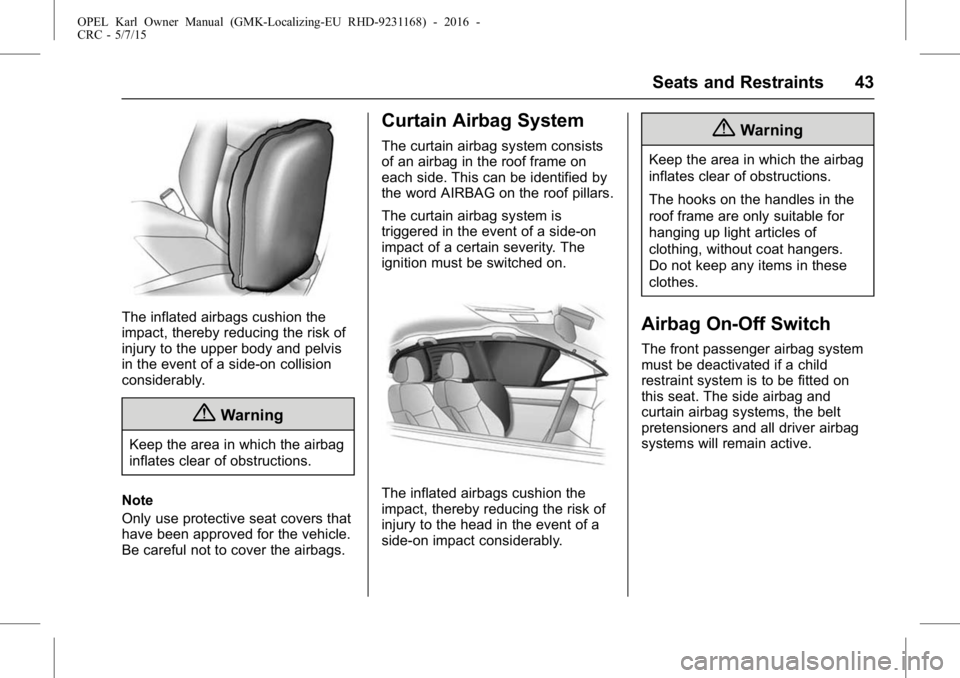
OPEL Karl Owner Manual (GMK-Localizing-EU RHD-9231168) - 2016 -
CRC - 5/7/15
Seats and Restraints 43
The inflated airbags cushion the
impact, thereby reducing the risk of
injury to the upper body and pelvis
in the event of a side-on collision
considerably.
{Warning
Keep the area in which the airbag
inflates clear of obstructions.
Note
Only use protective seat covers that
have been approved for the vehicle.
Be careful not to cover the airbags.
Curtain Airbag System
The curtain airbag system consists
of an airbag in the roof frame on
each side. This can be identified by
the word AIRBAG on the roof pillars.
The curtain airbag system is
triggered in the event of a side-on
impact of a certain severity. The
ignition must be switched on.
The inflated airbags cushion the
impact, thereby reducing the risk of
injury to the head in the event of a
side-on impact considerably.
{Warning
Keep the area in which the airbag
inflates clear of obstructions.
The hooks on the handles in the
roof frame are only suitable for
hanging up light articles of
clothing, without coat hangers.
Do not keep any items in these
clothes.
Airbag On-Off Switch
The front passenger airbag system
must be deactivated if a child
restraint system is to be fitted on
this seat. The side airbag and
curtain airbag systems, the belt
pretensioners and all driver airbag
systems will remain active.
Page 45 of 217
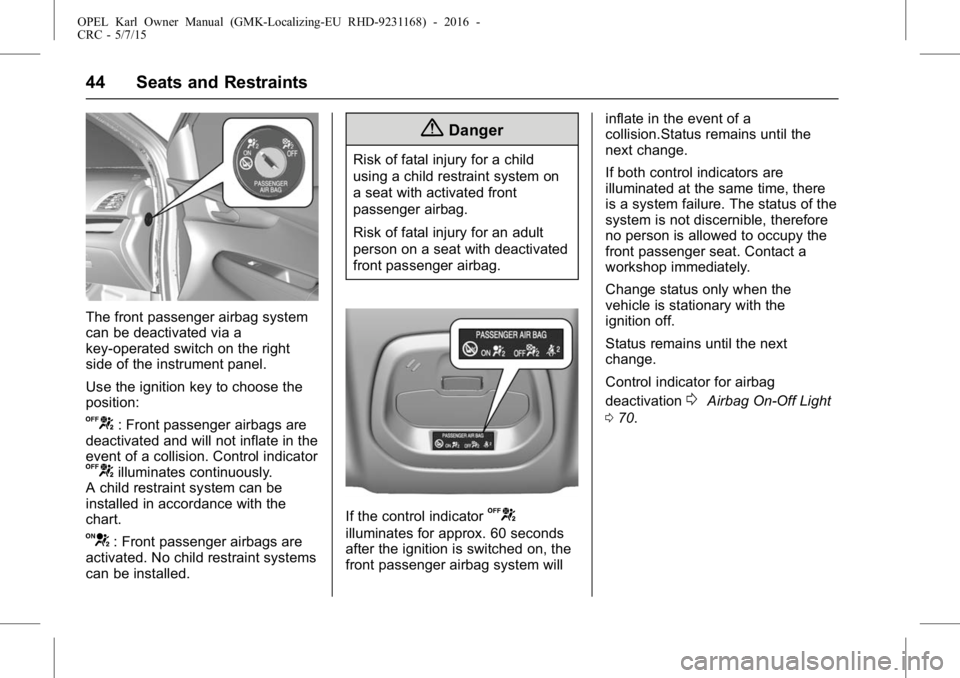
OPEL Karl Owner Manual (GMK-Localizing-EU RHD-9231168) - 2016 -
CRC - 5/7/15
44 Seats and Restraints
The front passenger airbag system
can be deactivated via a
key-operated switch on the right
side of the instrument panel.
Use the ignition key to choose the
position:
U: Front passenger airbags are
deactivated and will not inflate in the
event of a collision. Control indicator
Uilluminates continuously.
A child restraint system can be
installed in accordance with the
chart.
V: Front passenger airbags are
activated. No child restraint systems
can be installed.
{Danger
Risk of fatal injury for a child
using a child restraint system on
a seat with activated front
passenger airbag.
Risk of fatal injury for an adult
person on a seat with deactivated
front passenger airbag.
If the control indicatorU
illuminates for approx. 60 seconds
after the ignition is switched on, the
front passenger airbag system will inflate in the event of a
collision.Status remains until the
next change.
If both control indicators are
illuminated at the same time, there
is a system failure. The status of the
system is not discernible, therefore
no person is allowed to occupy the
front passenger seat. Contact a
workshop immediately.
Change status only when the
vehicle is stationary with the
ignition off.
Status remains until the next
change.
Control indicator for airbag
deactivation
0Airbag On-Off Light
0 70.
Page 46 of 217
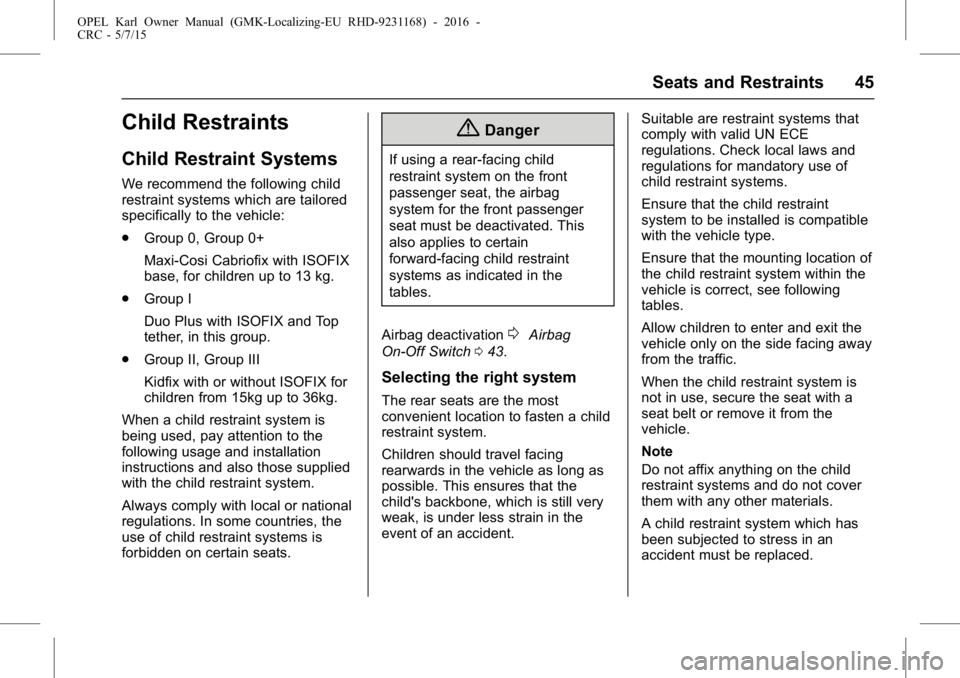
OPEL Karl Owner Manual (GMK-Localizing-EU RHD-9231168) - 2016 -
CRC - 5/7/15
Seats and Restraints 45
Child Restraints
Child Restraint Systems
We recommend the following child
restraint systems which are tailored
specifically to the vehicle:
.Group 0, Group 0+
Maxi-Cosi Cabriofix with ISOFIX
base, for children up to 13 kg.
. Group I
Duo Plus with ISOFIX and Top
tether, in this group.
. Group II, Group III
Kidfix with or without ISOFIX for
children from 15kg up to 36kg.
When a child restraint system is
being used, pay attention to the
following usage and installation
instructions and also those supplied
with the child restraint system.
Always comply with local or national
regulations. In some countries, the
use of child restraint systems is
forbidden on certain seats.
{Danger
If using a rear-facing child
restraint system on the front
passenger seat, the airbag
system for the front passenger
seat must be deactivated. This
also applies to certain
forward-facing child restraint
systems as indicated in the
tables.
Airbag deactivation
0Airbag
On-Off Switch 043.
Selecting the right system
The rear seats are the most
convenient location to fasten a child
restraint system.
Children should travel facing
rearwards in the vehicle as long as
possible. This ensures that the
child's backbone, which is still very
weak, is under less strain in the
event of an accident. Suitable are restraint systems that
comply with valid UN ECE
regulations. Check local laws and
regulations for mandatory use of
child restraint systems.
Ensure that the child restraint
system to be installed is compatible
with the vehicle type.
Ensure that the mounting location of
the child restraint system within the
vehicle is correct, see following
tables.
Allow children to enter and exit the
vehicle only on the side facing away
from the traffic.
When the child restraint system is
not in use, secure the seat with a
seat belt or remove it from the
vehicle.
Note
Do not affix anything on the child
restraint systems and do not cover
them with any other materials.
A child restraint system which has
been subjected to stress in an
accident must be replaced.
Page 47 of 217
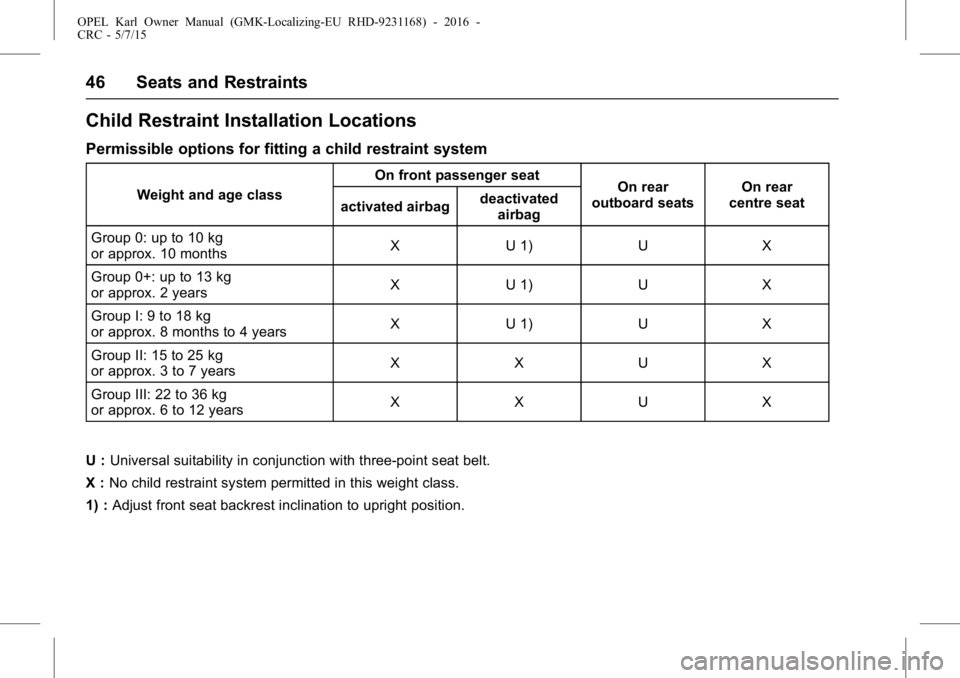
OPEL Karl Owner Manual (GMK-Localizing-EU RHD-9231168) - 2016 -
CRC - 5/7/15
46 Seats and Restraints
Child Restraint Installation Locations
Permissible options for fitting a child restraint system
Weight and age classOn front passenger seat
On rear
outboard seats On rear
centre seat
activated airbag deactivated
airbag
Group 0: up to 10 kg
or approx. 10 months X
U 1) UX
Group 0+: up to 13 kg
or approx. 2 years X
U 1) UX
Group I: 9 to 18 kg
or approx. 8 months to 4 years X
U 1) UX
Group II: 15 to 25 kg
or approx. 3 to 7 years X
XU X
Group III: 22 to 36 kg
or approx. 6 to 12 years X
XU X
U : Universal suitability in conjunction with three-point seat belt.
X : No child restraint system permitted in this weight class.
1) : Adjust front seat backrest inclination to upright position.
Page 48 of 217
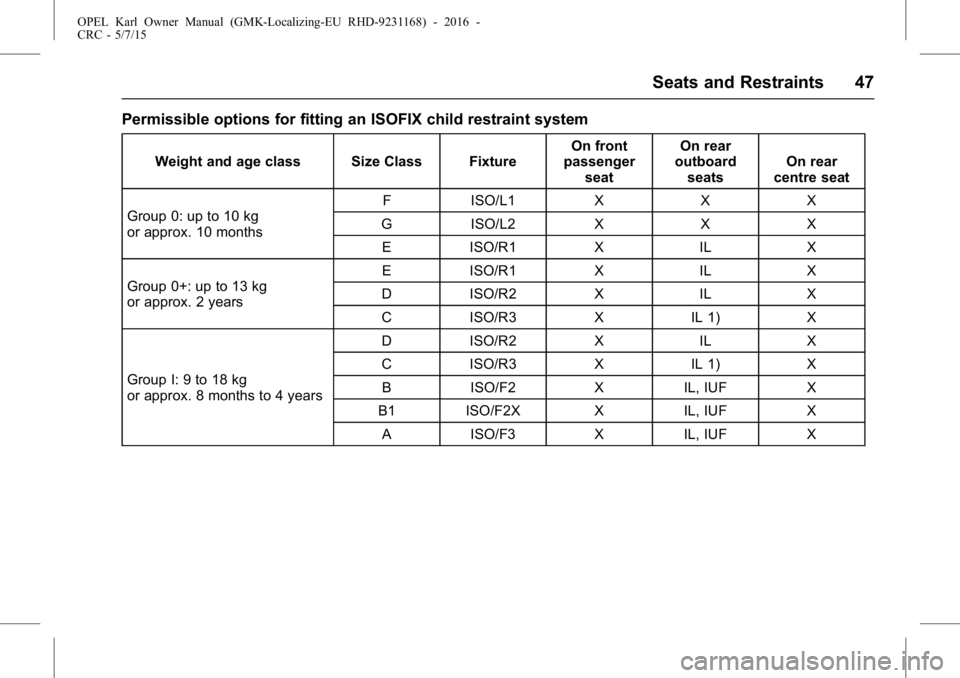
OPEL Karl Owner Manual (GMK-Localizing-EU RHD-9231168) - 2016 -
CRC - 5/7/15
Seats and Restraints 47
Permissible options for fitting an ISOFIX child restraint system
Weight and age class Size Class FixtureOn front
passenger seat On rear
outboard seats On rear
centre seat
Group 0: up to 10 kg
or approx. 10 months F
ISO/L1 XXX
G ISO/L2 XXX
E ISO/R1 XIL X
Group 0+: up to 13 kg
or approx. 2 years E
ISO/R1 XIL X
D ISO/R2 XIL X
C ISO/R3 XIL 1) X
Group I: 9 to 18 kg
or approx. 8 months to 4 years D
ISO/R2 XIL X
C ISO/R3 XIL 1) X
B ISO/F2 XIL, IUF X
B1 ISO/F2X XIL, IUF X
A ISO/F3 XIL, IUF X
Page 49 of 217
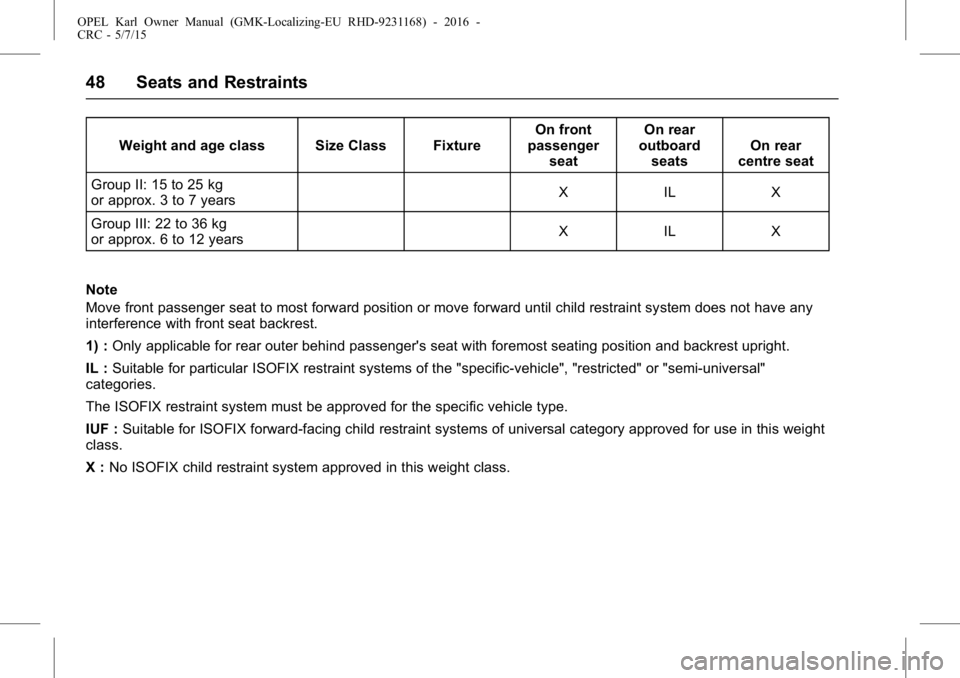
OPEL Karl Owner Manual (GMK-Localizing-EU RHD-9231168) - 2016 -
CRC - 5/7/15
48 Seats and Restraints
Weight and age class Size Class FixtureOn front
passenger seat On rear
outboard seats On rear
centre seat
Group II: 15 to 25 kg
or approx. 3 to 7 years X IL X
Group III: 22 to 36 kg
or approx. 6 to 12 years X IL X
Note
Move front passenger seat to most forward position or move forward until child restraint system does not have any
interference with front seat backrest.
1) : Only applicable for rear outer behind passenger's seat with foremost seating position and backrest upright.
IL : Suitable for particular ISOFIX restraint systems of the "specific-vehicle", "restricted" or "semi-universal"
categories.
The ISOFIX restraint system must be approved for the specific vehicle type.
IUF : Suitable for ISOFIX forward-facing child restraint systems of universal category approved for use in this weight
class.
X : No ISOFIX child restraint system approved in this weight class.
Page 50 of 217
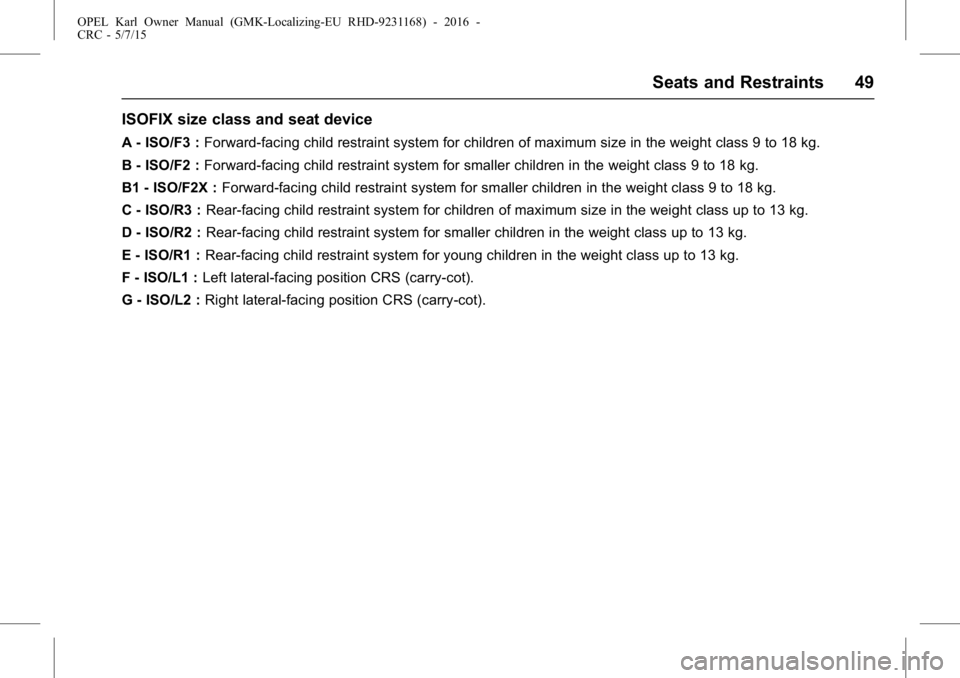
OPEL Karl Owner Manual (GMK-Localizing-EU RHD-9231168) - 2016 -
CRC - 5/7/15
Seats and Restraints 49
ISOFIX size class and seat device
A - ISO/F3 :Forward-facing child restraint system for children of maximum size in the weight class 9 to 18 kg.
B - ISO/F2 : Forward-facing child restraint system for smaller children in the weight class 9 to 18 kg.
B1 - ISO/F2X : Forward-facing child restraint system for smaller children in the weight class 9 to 18 kg.
C - ISO/R3 : Rear-facing child restraint system for children of maximum size in the weight class up to 13 kg.
D - ISO/R2 : Rear-facing child restraint system for smaller children in the weight class up to 13 kg.
E - ISO/R1 : Rear-facing child restraint system for young children in the weight class up to 13 kg.
F - ISO/L1 : Left lateral-facing position CRS (carry-cot).
G - ISO/L2 : Right lateral-facing position CRS (carry-cot).